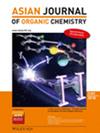通过黄原酸盐或硫代碳酸盐与醇的光催化脱氧烷基化
IF 2.8
4区 化学
Q1 CHEMISTRY, ORGANIC
引用次数: 0
摘要
光催化策略的最新进展扩大了烷基化剂的范围,包括烷基羧酸和饱和烃。值得注意的是,与传统的烷基化试剂(如烷基卤化物)相比,醇具有可用性、稳定性和安全性。本文综述了近年来利用醇进行光催化脱氧烷基化反应的研究进展,特别是通过形成黄原酸盐或硫代碳酸盐。本文章由计算机程序翻译,如有差异,请以英文原文为准。
Photocatalytic Deoxygenative Alkylation with Alcohols via Xanthates or Thionocarbonates
Recent advancements in photocatalytic strategies have expanded the range of alkylating agents, including alkyl carboxylic acids and saturated hydrocarbons. Notably, alcohols are preferred for their availability, stability, and safety compared to traditional alkylating reagents such as alkyl halides. This review summarizes recent developments in photocatalytic deoxygenative alkylation using alcohols, specifically through the formation of xanthates or thionocarbonates.
求助全文
通过发布文献求助,成功后即可免费获取论文全文。
去求助
来源期刊

Asian Journal of Organic Chemistry
CHEMISTRY, ORGANIC-
CiteScore
4.70
自引率
3.70%
发文量
372
期刊介绍:
Organic chemistry is the fundamental science that stands at the heart of chemistry, biology, and materials science. Research in these areas is vigorous and truly international, with three major regions making almost equal contributions: America, Europe and Asia. Asia now has its own top international organic chemistry journal—the Asian Journal of Organic Chemistry (AsianJOC)
The AsianJOC is designed to be a top-ranked international research journal and publishes primary research as well as critical secondary information from authors across the world. The journal covers organic chemistry in its entirety. Authors and readers come from academia, the chemical industry, and government laboratories.
 求助内容:
求助内容: 应助结果提醒方式:
应助结果提醒方式:


